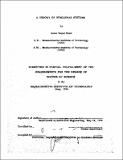A theory of nonlinear systems
Author(s)
Bose, Amar G
DownloadFull printable version (11.54Mb)
Other Contributors
Massachusetts Institute of Technology. Dept. of Electrical Engineering.
Advisor
Y.W. Lee.
Terms of use
Metadata
Show full item recordAbstract
Introduction: A physically realizable nonlinear system, like a linear one, is a system whose present output is a function of the past of its input. We may regard the system as a computer that operates on the past of one time function to yield the present value of another time function. Mathematically we say that the system performs a transformation on the past of its input to yield its present output. When this transformation is linear (the case of linear systems) we can take advantage of the familiar convolution integral to obtain the present output from the past of the input and the system is said to be characterized by its response to an impulse. That is, the response of a linear system to an impulse is sufficient to determine its response to any input. When the transformation is nonlinear we no longer have a simple relation like the convolution integral relating the output to the past of the input and the system can no longer be characterized by its response to an impulse since superposition does not apply. Wiener has shown, however, that we can characterize a nonlinear system by a set of coefficients and that these coefficients can be determined from a knowledge of the response of the system to shot noise excitation. Thus, shot noise occupies the same position as a probe for investigating nonlinear systems that the impulse occupies as a probe for investigating linear systems. The first section of this thesis is devoted to the Wiener theory of nonlinear system characterization. Emphasis is placed on important concepts of this theory that are used in succeeding chapters to develop a theory for determining optimum nonlinear systems.
Description
Thesis (Sc. D.)--Massachusetts Institute of Technology, Dept. of Electrical Engineering, 1956. "June, 1956." Includes bibliographical references (leaf 113).
Date issued
1956Department
Massachusetts Institute of Technology. Department of Electrical Engineering; Massachusetts Institute of Technology. Department of Electrical Engineering and Computer SciencePublisher
Massachusetts Institute of Technology
Keywords
Electrical Engineering.